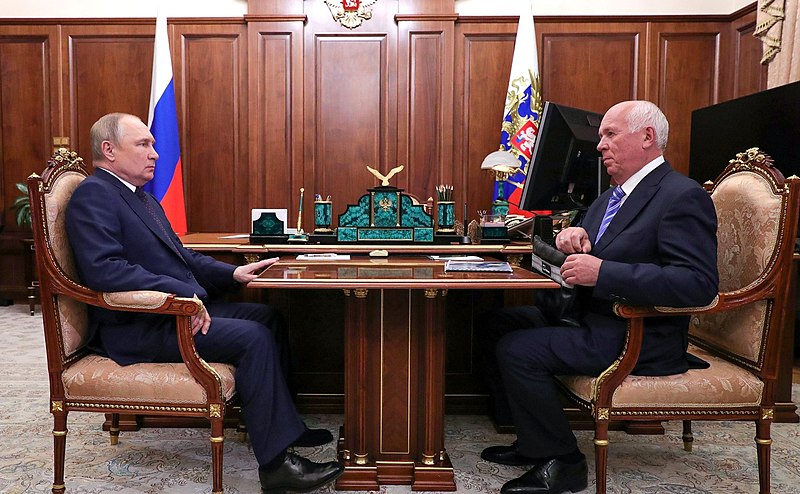 Source: Russian presidency
Source: Russian presidencyOutside of dynamics on the battlefield, a key question underlying the Russian invasion of Ukraine has been how well Moscow will manage its economy and finances, which influence the Kremlin’s ability to provide new and repaired equipment to its troops on the ground. Despite Western sanctions, the Russian economy has continued humming along and may grow 3.6 percent this year over 2023, according to International Monetary Fund (IMF) estimates, which suggests a healthy war-time economy. Underneath the rosy top-level outlook, however, signs of strain are beginning to show, particularly in Russia’s battle with inflation.
Last week, the head of Russian state arms conglomerate Rostec, Sergei Chemezov, spoke before the Federation Council and warned about how the high cost of money, imposed to rein in price growth, is impacting manufacturers’ profitability. Though Russia has worked to ramp up industrial activity, especially in the defense sector, the current cost of rubles is “a serious brake on further industrial growth,” Chemezov said. He pointed to the fact that contracts, particularly multi-year export deals, will often include only partial advance payments, with the rest of the financing to be made up on credit that is increasingly more expensive to obtain, eating into profits.
“Simply, if we continue to work like this, then almost the majority of our enterprises will go bankrupt,” Chemezov warned.
Though the Rostec official wasn’t the only Russian businessman to bemoan the tight financial conditions, his position as head of Rostec makes his commentary quite significant, given that the conglomerate integrates much of Russia’s defense industry under its umbrella. That includes armored vehicle and artillery manufacturer UralVagonZavod, ammunition supplier Tecmash, and military electronics firm KRET, whose products are crucial for the Russian Armed Forces. To be sure, the Kremlin won’t let these state-owned firms collapse, particularly during a war, but keeping the sector afloat, such as through injecting further state money, is adding to the inflation problem.
Inflation spiked after Russia launched its invasion of Ukraine in February 2022, peaking two months after the war’s start at an annualized rate of 17.8 percent. The rapid price growth prompted the Central Bank of Russia (CBR) to aggressively raise its key interest rate, which was largely successful in containing the price explosion. Inflation cooled through the first half of 2023 – before beginning to creep upwards again later that year, forcing the CBR to step back into rate-hiking mode.
Two days after Chemezov and other business leaders spoke, the CBR delivered yet another interest rate hike, raising its benchmark rate 200 bps to 21.00 percent. In an accompanying statement, the bank noted that inflation is ‘considerably’ higher than its forecast from only a few months ago. “Further tightening of monetary policy is required to ensure the return of inflation to the target and reduce inflation expectations,” the CBR wrote, teeing up another rate hike at its next meeting in December. Russian bonds unsurprisingly sold off on the news, continuing their downward march, and the yield curve remains inverted, with very short-term paper yielding more than longer-dated debt.
On the face of it, the CBR’s policy stance appears far more restrictive than the available inflation data alone would require. The CBR said that inflation is running at an annualized rate of 8.4 percent as of its latest print in October, and will likely end the year between 8.0-8.5 percent – very far below the bank’s policy rate. Similar figures are found in the latest IMF data, which projects inflation to end 2024 at 7.9 percent and fall to 5.9 percent next year.
But the picture in reality is bleaker than what is shown in official statistics, as the government has classified significant portions of data to mask the true situation in the Russian economy. Indeed, the Stockholm Institute of Transition Economics published a special report on Russia’s war economy on October 1 that highlighted, “Official statistics, such as GDP growth and inflation rates, have been manipulated to support the narrative that the Russian economy is stable, but alternative measures suggest a different reality.” Hiding inflation data may be ‘easy’; squaring the manipulated numbers with tight monetary policy isn’t.
Russian government expenditures have risen significantly since the February 2022 invasion of Ukraine, as Moscow has devoted an ever-growing share of the budget towards its Armed Forces, stoking inflationary pressure. The expected FY2025 defense budget – RUB13.5 trillion ($138.5 billion) – is nearly four times greater than annual pre-war (2021) military outlays, now occupying around a third of total government spending. As a percentage of GDP, defense spending has risen from 2.6 percent in 2021 to well over 6 percent in next year’s budget.
That spending has certainly enabled the Russian defense industry to kick into high gear, ramping up production (or repair) of tanks, infantry fighting vehicles, artillery, and drones for delivery to the frontlines. Western sanctions have complicated Russia’s supply chain, but a CSIS report published in June detailed how Russia has circumvented the restrictions, leaning on imports from partners like China to rectify shortages of key components. The Russian Armed Forces, enjoying a greater volume of equipment and ammunition than its Ukrainian counterpart, has thus managed a slow-moving advance on the battlefield, pushing Ukraine’s defenses back, albeit at high equipment and personnel cost.
The wheels aren’t yet at imminent risk of falling off, meaning Moscow is not yet being pushed to a point that would force it to make serious choices about whether to continue its war. Indeed, much of the Kremlin’s war strategy assumes that Ukraine, augmented with Western aid, will have to blink first, as Kyiv’s donors’ generosity wanes over time. Even so, if Chemezov’s comments are any indication, the cost of the war is starting to catch up with the Russian economy. “Conservative financial policies can lead to stagflation,” he assessed. That economic strain could ultimately curb much of the Kremlin’s ambitions.
Military markets analyst, covering Eurasia, Middle East, and Africa.
image sources
- Putin-Chemezov_meeting_(2022-05-18)_01: Russian presidency




